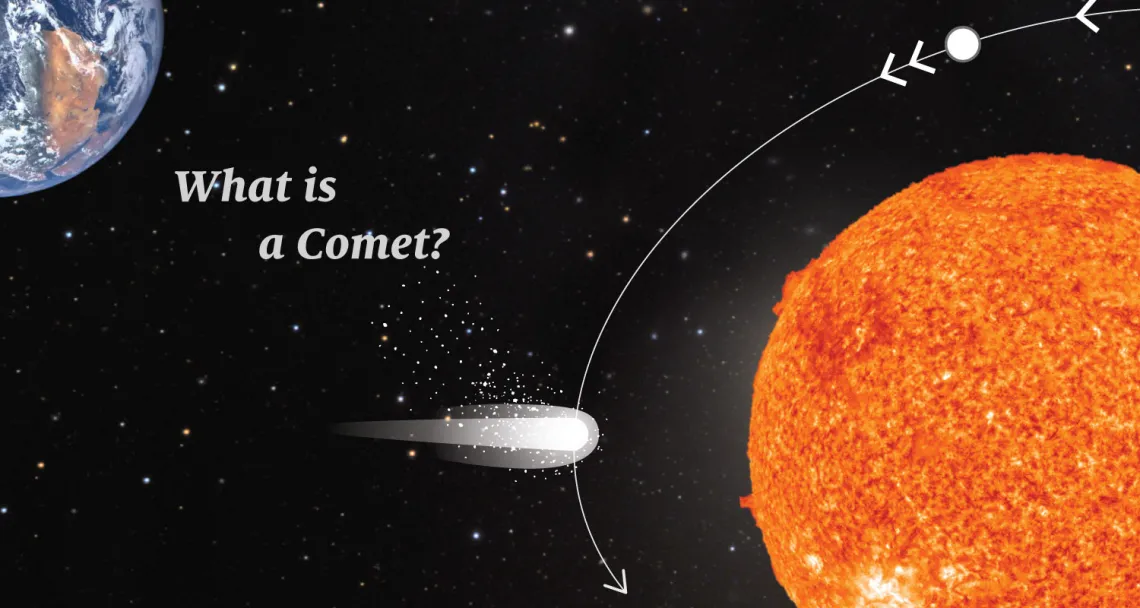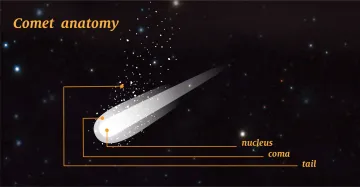What is a Comet?
Picture a dirty snowball up to a mile in diameter – an orbiting celestial body made up of ice, gases, rock, dust, and organic compounds. That’s a comet.

Illustration of a comet traveling through space between the earth and sun
Astronomers think comets originated from a region beyond the orbits of our solar system’s outermost planets, and were drawn closer to the sun. Some, called long-period comets, are in elliptical orbits that go far out beyond the planets and back. Others travel in shorter orbits nearer to the sun.
Essentially, scientists believe comets are leftovers from the beginning of our solar system, around 4.6 billion years ago, and that studying them will yield clues to the origin of the universe.
As a comet’s orbit draws nearer to the sun, it develops an atmosphere, or coma. Heat from the sun causes gases to expand, so the coma increases in size and extends thousands of kilometers – forming two tails, a dust tail and an ion (gas) tail, visible from Earth.
Some comets, called sun-grazers, smash right into the sun. Others can leave a trail of debris behind that can cause meteor showers on Earth. In fact, many scientist believe comets may have delivered the first carbon-based molecules to our planet, triggering the process of the origins of life.

What’s a Comet Made of?
Comets and asteroids may appear similar from long distances, but astronomers may not be able to tell the difference until they can spot the coma and tail of a comet.
Nucleus. The solid nucleus or core of a comet consists mostly of ice and dust coated with dark organic material, according to NASA, with the ice composed mainly of frozen water but perhaps other frozen substances as well, such as ammonia, carbon dioxide, carbon monoxide, and methane. The nucleus may have a small rocky core.
Coma. As the comet approaches the sun, the ice on the surface of the nucleus transforms into a gas, forming a cloud known as the coma.
Tail(s). Radiation from the sun pushes dust particles away from the coma, forming a dust tail, while charged particles from the sun convert some of the comet’s gases into ions, forming an ion tail. The dust tail reflects sunlight, so it appears yellow or white. The ion tail contains frozen material including carbon compounds which absorb- sunlight and fluoresces, emitting blue light.

Comets in History
As objects of mystery in early human history, comets were often perceived as omens. Astronomers kept extensive records for centuries, including illustrations of characteristic types of comet tails, times of cometary appearances and disappearances, and celestial positions. These records have turned out to be very useful to later astronomers.
- 1070-1080: The comet later designated Halley's Comet is pictured in the Bayeux Tapestry, a chronicle of the Battle of Hastings of 1066.
- 1449-1450: Astronomers make one of the first known efforts to record the paths of comets across the night sky.
- 1705: Edmond Halley publishes that the comets of 1531, 1607, and 1682 are the same object and predicts its return in 1758. The comet arrives on schedule and is later named Halley's Comet.
- 1986: An international fleet of five spacecraft converges on Halley’s Comet as it makes its regular (about every 76 years) pass through the inner solar system. The investigation reveals its nucleus is about 16 x 8 x 8 km in size, and photos show the gas streaming away as the ices in the nucleus are melted and evaporated by the heat of the sun.
- 1994: In the first observed planetary impact by a comet, awed scientists watch as fragments of comet Shoemaker-Levy 9 smash into Jupiter's atmosphere.
- 2004: NASA's Stardust spacecraft collects dust samples from comet Wild 2 and images the nucleus.
- 2006: The Stardust sample return capsule lands in Utah carrying cometary particles and interstellar dust.
- 2009: Scientists announce that the amino acid glycine, a building block of life, was collected by the Stardust spacecraft from comet Wild 2.
Watching Near-Earth Objects
More than 52 percent of all near-Earth objects, or NEOs – including comets – have been discovered by researchers at the University of Arizona. The Catalina Sky Survey, a NASA-funded project based at the UA Lunar and Planetary Lab in Tucson, Arizona, is an important contributor to the inventory of NEOs (which currently stands at more than 15,000) or, more specifically, the potentially hazardous asteroids (PHAs) that pose an impact risk to Earth and its inhabitants.

